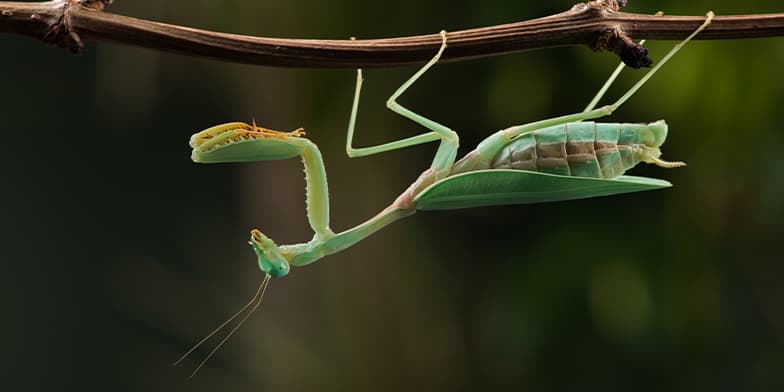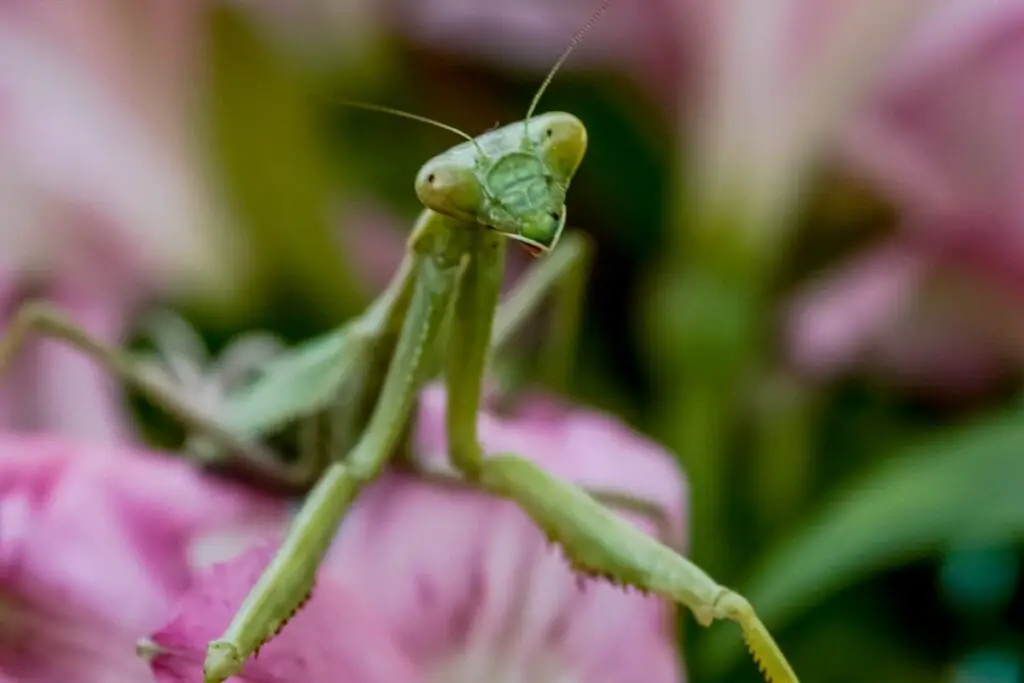
The Praying Mantis is a familiar insect that many people will recognise as a predator. Famous for many things, including their habit of eating their mating partners and their rather unique behavior when threatened. These beautiful insects are not commonly seen, and tend to raise a lot of questions when discovered. One of these is just how intelligent are they?
Studies have shown that mantis are intelligent, and that they can learn from negative experiences. They are among the smartest of predatory insects, and they have been observed to modify their hunting behaviors through learning. Although small, the mantis might be one of the most intelligent insects around.
This article is going to explore some of the reasons entomologists argue that mantis are intelligent. Let’s dive in.
What Behaviors Make Mantis Smart?
Like most predatory creatures, Mantis have to learn to improve their skill set if they want to eat well and stay alive. There are many reasons that Mantis have shown that they can adapt to their environment, and one of the more commonly cited examples is pointed at Mantis hunting behaviors. These bugs are often seen to modify and learn as they try to hunt specific kinds of prey, all in order to become successful at capturing their next meal.
Mantis is capable of eating small fish, mice, snakes, and more, which can surprise some people. These are not the same kind of prey that most insects are looking for, which means that the Mantis has to be an adaptive hunter that can adjust to these kinds of prey. Many Praying Mantis that have been used for studies were offered different situations where food could be caught.
In some of these situations, the Mantis would have to figure out how to get closer to the food in order to capture it. This is a common observable behavior when Mantis need to hunt fish. They will often figure out a way to hide close to the water and simply reach out to grab the fish as they swim by. This is a far different hunting behavior than what you might see from a spider. While a spider will build a trap for its prey and wait to catch things in the trap, the Mantis will find ways to directly capture prey with ease.

There are varieties of Mantis that even eat small birds, which requires that they be crafty enough and fast enough to catch something that is flying by quickly. Mantis are also unusual in that they are daytime hunters, which means that they have to be capable of creative hunting much the way a large predatory cat would be. Nighttime hunters have many advantages due to the dark being on their side that the Mantis does not enjoy during its daily hunting behaviors.
Mantis Have Specialized Eyes
Praying Mantis are visual hunters which is not common in the insect world. They are capable of advanced assessment of their environment which is reflected in the development of their eyes. This is partially an accommodation that is used to help them hunt during daytime hours but it is likely also an indication of their capacity for intelligence and understanding of their surroundings.
Studies show that Mantis might have access to 3D vision, which means that they are capable of assessing their entire surroundings and not just a small field of vision in front of them. This research has led to companion efforts to determine if the Praying Mantis actually has a brain rather than a simple central nervous system like a regular insect.
This is not a sophisticated brain, but new research is being done into the memory and response capacity of their brain that they use to assess these images and objects in 3 dimensions. This will likely reveal a unique way of learning and assessing opportunities that other insects are not capable of utilizing. Certainly, their hunting behavior indicates that they have these capacities within their understanding but there needs to be more study into the function of the Mantis brain to confirm that these researcher assumptions are correct.
Social Behavior That Indicates Intelligence
Mantis are solitary insects and they famously have complicated courtship rituals that involve the female eating her mate. This is not a common behavior for insect populations and the Mantis is among a small group of insects that live in this way.
Female Mantis are also capable of faking fertility in order to attract hapless males who will try to mate with them. She will then kill and eat them as soon as they approach. This is a very complex and tricky social behavior to fake and many scientists believe that this also indicates that these females are capable of rationalizing their situation in ways that other insects cannot.

To be able to assess that there is no available food and to hunt your own kind with this specialized feint is a really high-level behavior for an insect. This has been reproduced in studies and it has shown that there might be more to Mantis behavior and rationalizing processes than was thought previously. These females were also apparently aware that they were starving and almost always prevented the male from mating with them before they ate them.
These kinds of social behaviors indicate some higher reasoning processes and assessments of personal situations might be guiding survival and hunting behaviors of the Mantis. There are few insects that can craft such solutions on their own without a hive mind guiding these determinations. One often thinks of bees as higher thinkers in the insect world, but their process of isolating solutions is done with a group that thinks the method that the Mantis does not have access to.
Personalized decision-making is not a common factor in the insect world but the Mantis performs these behaviors frequently and with ease. While this might indicate a series of very carefully crafted innate responses to stimuli, it is not likely that an insect would be so aware of its situation and so flexible in its thinking just because of innate responses that have been programmed into its central nervous system.
The Mantis is One Smart Bug
The Praying Mantis shows promise of being identified as one of the smartest bugs around. There is increasing evidence that this is a very intelligent insect that sees in 3 dimensions and that is capable of adaptive hunting behaviors. As studies are done into the central nervous system and potential brain responses of these insects, it is likely that further information will come to light supporting the possibility that the Mantis is quite smart and capable when compared to many other insects.
The next time that you see a Mantis, remember that you are probably observing a creature that is able to define its own unique choices and make plans about its next move with higher thinking processes. This can open up an entirely new concept of how these insects operate on a daily basis and you might want to watch this insect interloper for a while to see what it decides to do. The Praying Mantis is at the center of a lot of exciting research and you can be sure that new and interesting information is on the horizon that will reveal many things about these unique insects.
References
Aversive Learning in the Praying Mantis (Tenodera aridifolia), a Sit and Wait Predator | Journal of Insect Behaviour
Praying Mantids | Entomology at the University of Kentucky
When a female mantis is hungry, she fakes fertility to snack on duped males | Washington Post
Researchers who made praying mantises wear glasses discover a new type of vision | Washington Post
Driven by a passion for those tiny creatures that rule our world, we at Bug Domain strive to be your go-to resource for information on insects.




